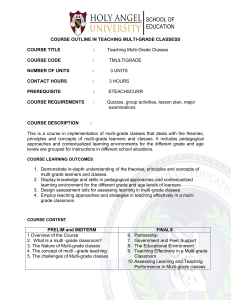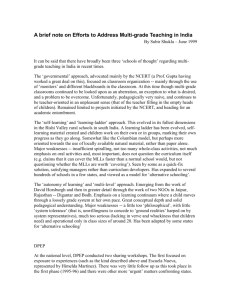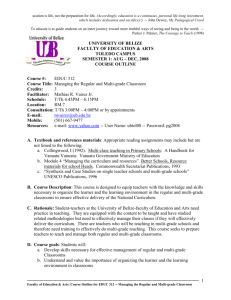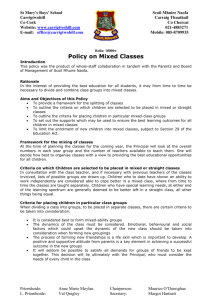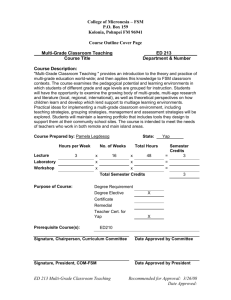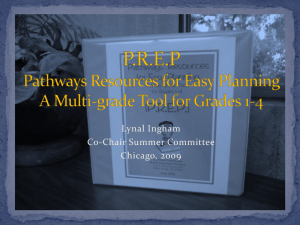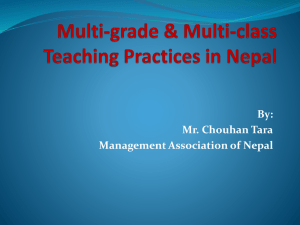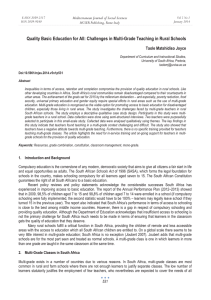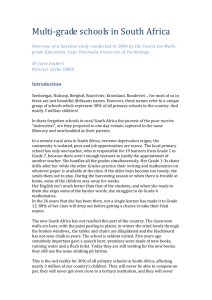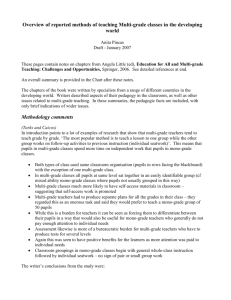Multigrade Teaching
advertisement
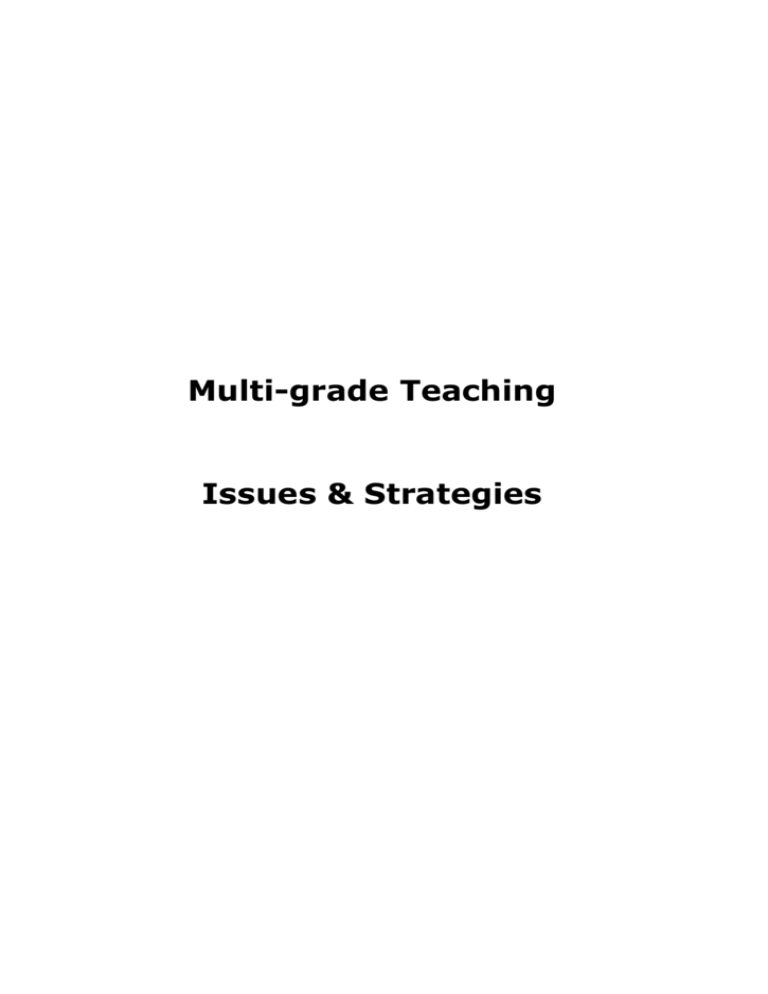
Multi-grade Teaching Issues & Strategies Class groups Should each separate class group, e.g. II, III & IV work on their own, at opposite type activities (oral v non-oral, even different subjects), or should the classroom operate as one large, but very mixed ability class where the same subject matter is dealt with simultaneously at the appropriate level for different children? E.g. all children doing creative writing at once or all children doing Comhrá Gaeilge or fractions together. Timetabling If you believe in the ‘simultaneous, integrated mixed ability group’ model rather than the ‘parallel but separate class groupings’ model consider the following: - which subjects or topics will/will not work in this way? - This will work for some aspects of Maths better than others - How rigid or flexible must the timetable be? - Is it more useful to timetable some subjects in block for a while than try to do everything every week, e.g. history/geography every second month? Seating arrangements: More than one approach is useful e.g. ABC…., mixed ability groups for Art, Oral Irish? 123… for similar ability groups, reading, maths concepts? Red, blue, Green; friendship groups for project work, religion etc. By having more than one group structure and separate labelling of groups, rapid interchange can take place with no time wasting. ‘Peer Tutorage’ employing children as mentors or helpers. Every child is a ‘helper’ for something or other – not necessarily the same pair together for everything. Sometimes the helper appointed to a younger child may, in fact, be the one who is receiving the help e.g. listening to the reading of a younger but better reader! These partnerships can be extended to several areas e.g. help to a child who is slow at taking down his/her homework. Ideal also to boost enjoyment of reading. Computers Computers are ideally suited to the multi-grade classroom. Ideal for ‘Write-a-BookProject’ – Ideal for special needs students – ‘Mavis Beacon teaches type’. Individualised learning programmes to reinforce existing learning e.g. maths. Ideal for high and low achievers. Reduce noise by using headphones. Also face the back of the monitor towards class. Remedial/Resource Teacher Resource teachers can be used very effectively in a multi-grade classroom as an extra teacher with whichever group is in the room rather than simply withdrawing the weaker children. 2 Space, Time, Roles….! In a small school (i.e. 7 teachers or less), does each teacher have to be alone with his/her class in a separate room all the time? Is there an alternative model or even optional model for some subjects/themes. Could individual children move between teachers to have certain needs addressed? Can an alternative model be used to ‘free up’ one or two teachers to engage in some school planning exercise? Can two or more small schools collaborate to expand the possibilities of co-operative teaching with/without whole school planning and staff development in mind? Split Classes Nowadays even in large schools, the prospect of split classes arises quite often. Issues to consider are: - Where in the school should they occur? - Who should teach this class? - Parental perceptions - Which half of the 1st class goes with 2nd and which half doesn’t? Why? - Are these children selected ability-wise or on the basis of their capacity to work in groups/on their own? What are the other factors? Experimenting If we accept that there are many advantages to multi-grade classes, could a large school benefit from attempting a multi-grade experiment e.g. instead of one 4th, one 5th and one 6th class, have 3 multi-grade classes of 5th, 5th & 6th! Teachers would need considerable training and confidence to try it. Parents perceptions??? Observation of good practice To enable teachers learn about good practise in multi-grade teaching it is essential that a teacher actually physically goes and observes an experienced practitioner in a real classroom situation. How can this be achieved – see point G. Organisational strategies to relieve chaos, stress and exhaustion of teacher (and children!) - use of clipboards for children - ‘Busy bee’ folders for extra work when tasks are completed and teacher is still busy - involve children in every conceivable way in the classroom - material storage and retrieval… - practise group change (point C) a lot in September - Use colours as well as icons to label groups, storage areas etc. - USSR (Uninterrupted Systematic Silent Reading) time as a breather for children and teacher as well as for reading– timetable displayed and explained to children - Inviting in people with specialist knowledge or skills to help with e.g. art, computers, music, PE, either to lead the group or to simply assist you (parents, extended community?) 3 - Do not give written work to keep children quiet – handwriting gets worse and corrections build up – teacher loses! - Do corrections on the spot, more effective and less stressful on the teacher, there are some exceptions, e.g. essays, for older children - Teach children how to ‘cross-correct’ each other’s maths and spellings - Teach class how to ‘self-correct’ from answer books, not all children can cope with the temptation – monitor carefully! - Teach history, geography, science/nature and religion through project work as much as possible - Whatever the nature of the groups (point c) make use of group leaders to act as ‘forepersons’ or as a type of ‘middle classroom management’ (that must be a new piece of jargon!!). These people assist with the rest of their group in: o Material/book storage and distribution o Focusing children on task at hand o Reinforcing instructions when necessary o Clarifying trivia o Supervising ground rules, e.g. levels of noise, talk acceptable during a variety activity o Build up a resource of graded task cards, activity packs, educational games which are self-administrated and self-evaluated. Select ones suitable to individuals as well as groups. o Mobile shelf trolley to cope with flexibility requirements of a multi-grade class o Multiple display boards to display work produced by different groups. Cost effective method: 3/8” cork tiles fixed to walls with silicone adhesive, ideal pin board o Reduce the number of texts as much as possible. A multiplicity of texts (easily achieved with a rental scheme) is useful to resource project work in history, geography, nature etc. This may be better than all using one text. Typical Problems with Multi-grade Classes - In a large school where there is only one ‘split class’, parents get different notions about being ‘kept back’ etc. - Parents don’t readily see the advantages of multi-grade classroom. - Small schools themselves often have inferiority complex about their size. - Teachers over extend themselves by trying to teach e.g. 3 separate classes like 3 separate teachers, this leads to serious burnout. - Text books are nearly all designed for single age classes, book 1-6 etc. The selection of texts can be a serious problem. Continuous programme texts are thin on the ground – however for teachers a lot of useful resources do exist and are ideal to multi-grade as well as for single grade classes e.g. ‘Módh an Aoibhnis’, ‘Windows on the World’, ‘Team Planet’ etc - Broad parental and teacher opinion is quite negative towards multi grade classes and particularly multi-grade schools. Moving to a multi-grade school 4 can be seen as a demotion! It is necessary to focus on the positive advantages of multi-grade education by: o highlighting the obvious advantages see point M o reminding ourselves that multi-grade schools have, and continue to serve our children very well indeed-a 2:1 majority of Classroom Management tutors are ‘products’ of multi-grade schools. This, I’m fairly sure is also true of a lot of other profession. o At parent/teacher meetings (special meeting on this matter) explain the positive advantages to multi-grade classes and dispel the myths re same. Explain the strategies you use and give their educational rationale. Use analogy of the family to illustrate above points. Try to involve parents more in shared reading especially but also in ‘shared maths’ where they can give so much help. Focus on the positive. Advantages to Multi-grade Classes - Younger children learn a lot from older ones even without it being planned. - Older children get constant reinforcement of what they have learned in previous year(s). - Children become independent learners by the nature of the classroom needs. - Co-operative discipline evolves though necessity as children learn personal and group responsibility from early on. - Children’s social skills mature earlier in multi-grade classes. - The multi-grade classroom, by its very make up, is more receptive and suitable to the essential tenets of the ‘new curriculum’, ie child centred, activity based, discovery methods, group work, thematic approach, integrated curriculum etc. - The multi-grade classroom is a natural extension from the child’s experience at home 0 multiple ages, needs and abilities. - Children find their own level easier in a multi-grade class – less likely to feel different than in a single age, ‘single-ability’ class. - In a multi-grade class the teacher is likely to teach a child for two or more years. This, generally, allows the teacher to get to know the child well and have a greater impact on affecting what the child learns. The high turnover of teachers to children in a single grade class discriminates against the teacher ever getting to know a child beyond a superficial level. If one accepts the correlation between how much, the knowing of a child’s experience, needs and ability effects the quality of teaching/learning, then the multi-grade classroom has a distinct advantage in this area. Conclusion If you believe that the method of our teaching/learning matters more than the content of our teaching/learning, then the multi-grade teacher will not attempt to be 2 or 3 teachers for 2 or 3 classes. To attempt this is to guarantee disaster for the children and rapid burnout for the teacher. Like remedial teaching, all the principals of multi-grade teaching will work in a single grade classroom but not always vice versa. The challenge is to constantly modify and develop a system that works and to reassure ourselves that the end does validate the means. 5
